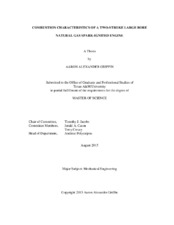| dc.description.abstract | Naturally, there are complex interactions among internal combustion engine parameters such as in-cylinder pressure, emissions, speed, and load. These basic relationships are studied in a naturally aspirated, spark-ignited, two-stroke, large-bore natural gas engine. The typical application for such an engine is operating heavy machinery such as large compressors and oil field pump jacks.
Cylinder pressure averaged over 300 cycles is captured for eight speeds from 350 to 525 RPM and six loads of 50% to 100% of maximum torque at each respective speed. Non-sequential individual cycle pressure curves are captured to depict cyclic variation at each operating point. Emissions are measured for each operating point. Equivalence ratio, delivery ratio, and trapping efficiencies are also calculated. The behavior of these parameters are then quantified and described in the context of cyclic variation.
It is shown that low load cyclic variation is extreme, having coefficient of variance (COV) of indicated mean effective pressure (IMEP) values over 40%. Low load cycles are shown to frequently misfire or experience partial burn. Cyclic variation is shown to decrease with increasing load and decreasing speed. Air flow rate is shown to increase with engine speed. It is also shown that the overall system equivalence ratio is highest at high loads and low speeds, and the values are between 0.55 and 0.90. Brake specific fuel consumption (BSFC) is suspected to decrease with increasing load, likely due to improved scavenging at high load. Delivery ratio is shown to be, on average, slightly greater than 1.0 at most operating conditions.
Fuel trapping efficiency has a complex trend with increasing speed. Air trapping efficiencies disagree with those calculated for fuel, and are likely incorrect due to the lean-burning nature of the engine. Scavenging efficiency results are not credible. Emissions of CO2, NO, and THC are shown (and emissions of CH4 are suspected) to have an inverse correlation with cyclic variation; emissions of O2 are shown (and emissions of CO are suspected) to have direct correlation with cyclic variation. | en |


